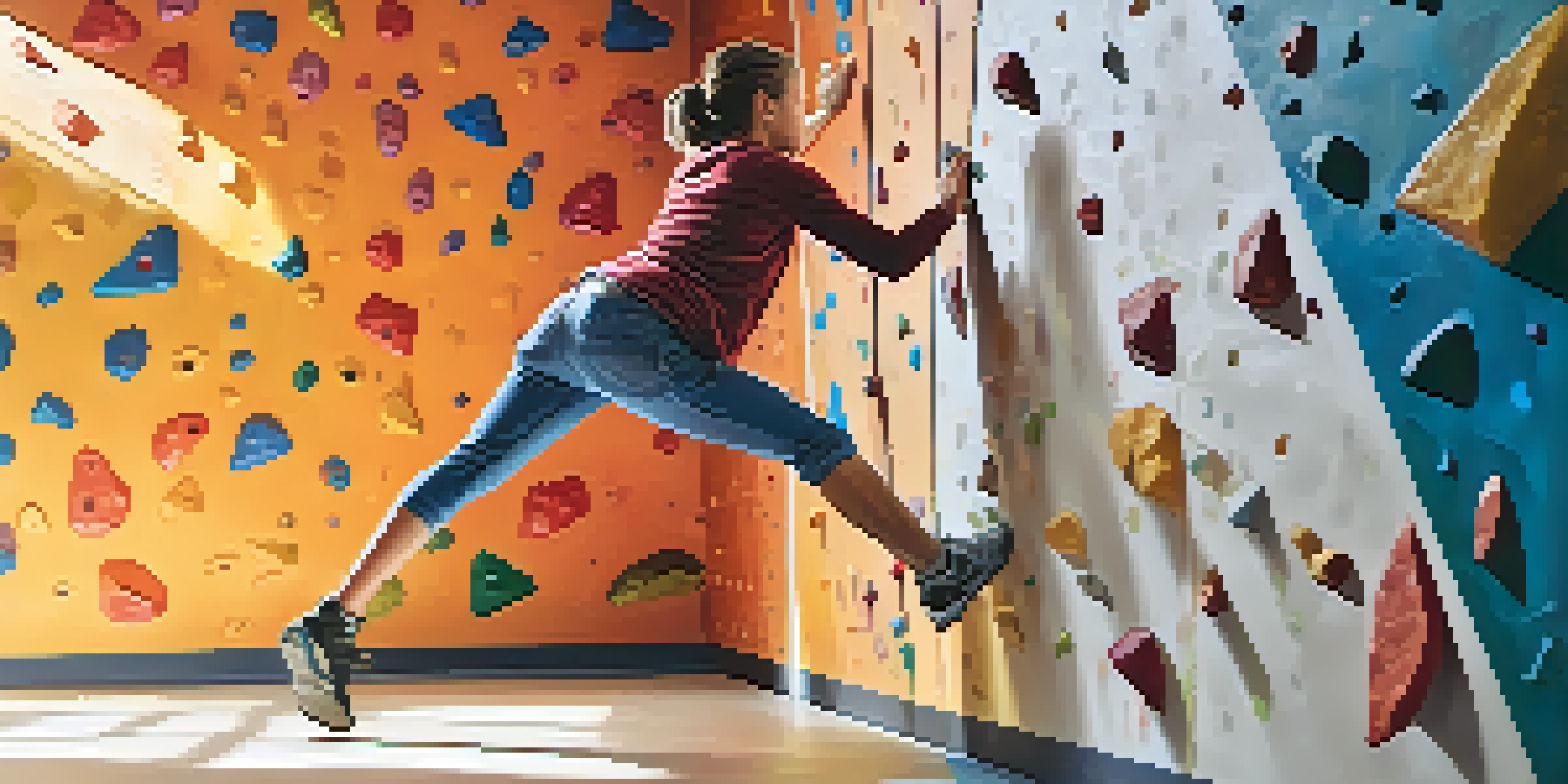Climbing Drills: Enhance Your Skills with Effective Practices

Understanding the Importance of Climbing Drills
Climbing drills are essential for climbers at any level, as they help refine technique and build strength. Just like any athlete, climbers need to practice specific movements to improve their skills. Drills allow climbers to focus on particular aspects of their performance, whether it’s footwork, body positioning, or grip strength.
Climbing is not just about strength, but also about technique and mental fortitude.
Incorporating drills into your training routine can lead to significant improvements in your climbing efficiency. For example, a focused footwork drill can help you become more precise in your movements, allowing you to conserve energy during climbs. With practice, these small adjustments can translate into big gains on the rock face.
Moreover, regular practice of climbing drills can help boost your confidence. As you become more skilled at specific techniques, you'll feel more capable when faced with challenging routes. This newfound confidence can make climbing not just easier, but also more enjoyable.
Incorporating Warm-Up Drills into Your Routine
Warming up is a crucial part of any climbing session, as it prepares your body for the physical demands ahead. Simple warm-up drills can help increase blood flow to your muscles and improve flexibility. Consider starting with dynamic stretches or easy climbing routes to get your body ready for more intense efforts.

A great warm-up drill involves traversing a wall at a low intensity, focusing on foot placements while keeping your hands off the holds. This not only warms up your muscles but also hones your footwork skills. By paying attention to your feet, you can build muscle memory that will benefit you during more challenging climbs.
Climbing Drills Enhance Technique
Regularly practicing climbing drills improves technique, strength, and confidence for climbers of all levels.
Don't overlook the mental aspect of warming up, either. Taking a few minutes to visualize your climbing goals or review the techniques you want to practice can set a positive tone for your session. This mental preparation can enhance your focus and performance as you tackle more difficult climbs.
Footwork Drills: The Foundation of Climbing Success
Footwork is often the unsung hero of climbing; excellent footwork can make even the hardest routes feel manageable. One effective drill is the silent foot drill, where you aim to place your foot on holds without making a sound. This encourages precision in your foot placements and helps you develop a keen sense of balance.
The secret to climbing is to focus not just on where you're going, but also on how you get there.
Another useful exercise is the 'one foot' drill, where you climb using only one foot at a time. By doing this, you’ll force yourself to engage your core and focus on body positioning. This drill not only improves your footwork but also enhances your overall strength and stability.
Over time, improving your footwork will lead to greater efficiency and reduced fatigue during climbs. You'll find that as you become more adept at foot placement, your hands will have to do less work, allowing you to conserve energy for the crux of the climb.
Strength and Conditioning Drills for Climbers
To climb at your best, strength and conditioning are vital components of your training. Incorporating exercises like pull-ups, push-ups, and core workouts can significantly improve your climbing performance. These strength drills can help you build the muscle necessary for powerful movements on the wall.
Additionally, consider adding specific grip strength drills, such as hangboard training, to your routine. Hangboards allow you to target your finger strength, which is crucial for gripping holds on rock faces. Start with shorter hang times and gradually increase the duration as your strength improves.
Warm-Ups Prepare for Climbing
Incorporating warm-up drills increases muscle readiness and mental focus, setting a positive tone for climbing sessions.
Remember that conditioning isn’t just about strength; it’s also about endurance. Incorporating circuit training with climbing-specific exercises can boost your stamina, allowing you to tackle longer climbs without burning out. This balanced approach to strength and conditioning will prepare you for any climbing challenge.
Technique Drills to Improve Climbing Efficiency
Efficient climbing relies heavily on technique, and specific drills can help you polish your skills. One effective technique drill is the 'flagging' exercise, where you practice extending one leg out to maintain balance while climbing. This helps you learn how to shift your weight effectively and use your legs more efficiently.
Another great drill is the 'downclimbing' exercise, which challenges you to descend the route you just climbed. This forces you to think critically about your holds and body movements in reverse. By understanding how to downclimb efficiently, you'll gain a deeper insight into your climbing techniques.
As you practice these drills, focus on maintaining a relaxed and fluid motion. Good technique often means avoiding unnecessary tension, which can lead to fatigue. By improving your technique through targeted drills, you'll find yourself climbing with greater ease and control.
Mental Training Drills for Climbers
Climbing isn't just a physical challenge; it also requires mental fortitude. Mental training drills can help you develop focus, confidence, and resilience. One simple drill involves visualization techniques, where you mentally rehearse climbing routes before attempting them in real life.
Another effective strategy is to practice mindfulness while climbing. Focus on your breathing and the sensations in your body as you move up the wall. This practice can help you stay present, reduce anxiety, and improve your overall performance.
Mental Training Boosts Performance
Engaging in mental training drills fosters focus and resilience, crucial for overcoming challenges on climbs.
Incorporating mental drills into your routine can lead to improved decision-making during climbs. As you become more attuned to your thoughts and feelings, you'll find it easier to manage fear and stay composed in challenging situations. This mental edge can be just as important as physical strength in achieving your climbing goals.
Setting Goals and Tracking Progress with Drills
To get the most out of your climbing drills, it's essential to set specific, achievable goals. These goals can provide a roadmap for your training sessions, helping you stay focused and motivated. For instance, you might aim to improve your footwork on a particular route or increase the number of pull-ups you can do.
Keeping a training journal can be an invaluable tool for tracking your progress. Record the drills you complete, your successes, and areas where you’d like to improve. This reflection not only helps you see how far you've come but also allows you to adjust your training approach as needed.

As you monitor your progress, celebrate your achievements, no matter how small. Recognizing milestones can boost your motivation and remind you of the hard work you’ve put in. With clear goals and a commitment to tracking your journey, you'll continue to enhance your climbing skills over time.